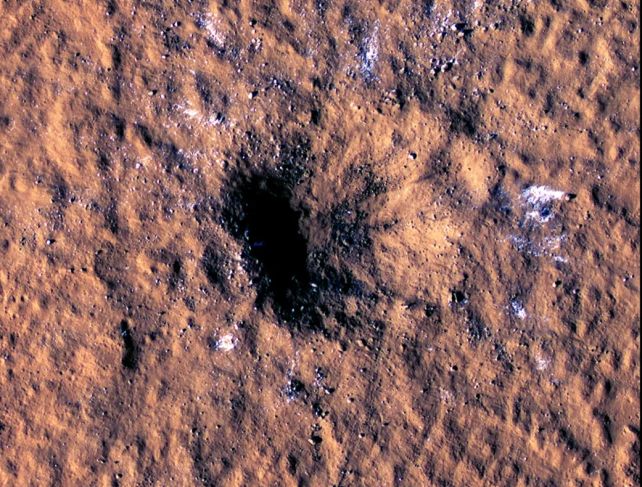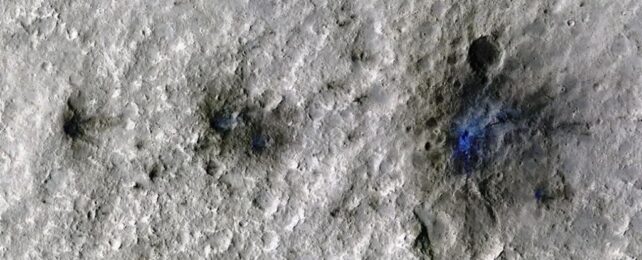For some planets, the meteorite bombardment just never stops.
New analysis of data collected by a seismometer on Mars has revealed that space rocks slam into the red planet far more frequently than we ever suspected.
In fact, it seems Mars is copping an absolute thrashing. Based on the number of nearby impact-related tremors detected by the Mars InSight lander during its tenure, a team of scientists has estimated that Mars experiences almost daily impacts from rocks the size of a basketball smashing into its surface.
"This rate was about five times higher than the number estimated from orbital imagery alone," says planetary scientist and co-lead author Géraldine Zenhäusern of ETH Zurich in Switzerland.
"Aligned with orbital imagery, our findings demonstrate that seismology is an excellent tool for measuring impact rates."
Mars InSight, in the four years it spent monitoring the Martian interior until it gave up the ghost at the end of 2022, revolutionized our understanding of the red planet.
We had previously thought that Mars was probably pretty boring inside; InSight revealed a whole wealth of tectonic and magmatic activity that had previously escaped our notice, while also revealing the planet's interior composition.

The other main thing that the sensitive laboratory detected was the faint tremors of rocks smacking into the Martian crust. This gave scientists a new tool for estimating the rate of impacts on Mars, which in turn can help calibrate our understanding of the planet's geological history.
The rate of crater formation on a planetary surface can help gauge how old that surface is. Surfaces with more craters are thought to be older; those with fewer are correspondingly younger. If we know the rate at which those craters appear, we can determine how old a given surface is.
"By using seismic data to better understand how often meteorites hit Mars and how these impacts change its surface, we can start piecing together a timeline of the red planet's geological history and evolution," explains planetary scientist and co-lead author Natalia Wójcicka of Imperial College London.
"You could think of it as a sort of 'cosmic clock' to help us date Martian surfaces, and maybe, further down the line, other planets in the Solar System."
Here on Earth, thousands of meteors fall each year, but they mostly disintegrate high up in the atmosphere, while we lowly surface dwellers remain oblivious. Mars has an atmosphere, but it's more than 100 times thinner than Earth's. That means Mars doesn't have the same protection against impacts; rocks can fall from space pretty much unimpeded.
In addition, Mars is very close to the asteroid belt between its orbit and the orbit of Jupiter, so there are a lot of rocks in the vicinity to contribute to a high impact rate.
Previous estimates of the Martian impact rate have relied on satellite imagery. Satellites in Mars orbit take ongoing photos of the surface, logging the appearance of new craters. This is an imperfect means of counting impacts on its own, but until InSight, it was the best option available.

"While new craters can best be seen on flat and dusty terrain where they really stand out, this type of terrain covers less than half of the surface of Mars," Zenhäusern explains. "The sensitive InSight seismometer, however, could hear every single impact within the landers' range."
The researchers combined the two sets of data, counting new craters, and tracking them to InSight detections. This allowed them to calculate how many impacts had occurred near the lander in the course of a year, and extrapolate that to a global impact rate.
This revealed that between 280 and 360 impacts that produce a crater more than 8 meters (26 feet) occur on Mars every year – a rate of around one a day. And craters more than 30 meters (98 feet) across appear around once a month.
This is not only relevant to understanding the history of Mars, it also provides valuable information to help prepare for human exploration of the red planet.
"This is the first paper of its kind to determine how often meteorites impact the surface of Mars from seismological data – which was a level one mission goal of the Mars InSight Mission," says seismologist and geodynamicist Domenico Giardini of ETH Zurich. "Such data factors into the planning for future missions to Mars."
The research has been published in Nature Astronomy.
